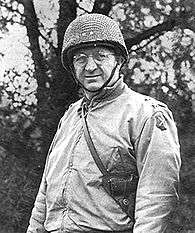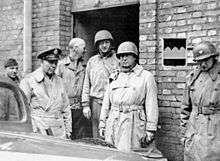Manton S. Eddy
| Lieutenant General Manton Sprague Eddy | |
|---|---|
 | |
| Born |
May 16, 1892 Chicago, Illinois, United States |
| Died |
April 10, 1962 (aged 69) Fort Benning, Georgia, United States |
| Allegiance |
|
| Service/branch |
|
| Years of service | 1916–1953 |
| Rank |
|
| Unit |
|
| Commands held |
11th Machine Gun Battalion 114th Infantry Regiment 9th Infantry Division XII Corps United States Army Command and General Staff College Seventh Army United States Army Europe |
| Battles/wars |
World War I World War II |
| Awards |
Distinguished Service Cross Silver Star Legion of Merit (2) |
Lieutenant General Manton Sprague Eddy (May 16, 1892 – April 10, 1962) was a senior United States Army officer who served in both World War I and World War II. During the latter conflict he served with distinction, commanding the 9th Infantry Division and later XII Corps in the campaign in Western Europe, playing a large part in the Battle of the Bulge in late December 1944.
Biography
Early life and military career
Eddy graduated from Shattuck Military School in Faribault, Minnesota, in 1913. He enlisted in the Infantry Branch of the United States Army in 1916 and was commissioned as an officer as a second lieutenant of infantry in early 1918, the year after the American entry into World War I the previous April. With the rank of captain, he was a company commander in the 11th Machine Gun Battalion, part of the 4th Division of the American Expeditionary Force (AEF). He was sent to the Western Front with his division in May 1918 and was wounded in August, when the tide of the war had turned against the Germans. He recovered soon after and commanded a machine gun battalion until the end of the war on November 11, 1918.[1]
Between the wars
Promoted to the war-time rank of major, he served in Allied-occupied Germany until 1919 when he returned to the United States. Relegated to the rank of captain in the Regular Army in 1920, Eddy married Mamie Peabody Buttolph in 1921. During the period between the wars, he was a member of the Infantry Board and was a student, later an instructor, at both the U.S. Army Infantry School and the U.S. Army Command and General Staff School. He also served as Professor of Military Science at Riverdale Military Academy.
By 1940, during World War II (although the United States was still officially neutral at this point), he was an intelligence officer with III Corps. In 1941 Eddy assumed command of the 114th Infantry Regiment, part of the 44th Infantry Division, a National Guard formation.[2]
World War II

In March 1942, three months after the Japanese attack on Pearl Harbor and the subsequent American entry into the conflict, he was promoted to the one-star general officer rank of brigadier general and became the Assistant Division Commander (ADC) of the 9th Infantry Division.[3] In July he was promoted to the two-star rank of major general and became Commanding General (CG) of the 9th Infantry Division. He led the division overseas in the Allied campaign in North Africa, later leading the 9th in the Allied invasion of Sicily in July/August 1943. In November the division was sent to England in preparation for the Allied invasion of Northern France. Eddy led the 9th Infantry Division in the early stages of Operation Overlord, codename for the Battle of Normandy, landing on Utah Beach four days after the D-Day landings of June 6, 1944. For his role in the capture of the French port of Cherbourg, Eddy was awarded the Distinguished Service Cross. In August, he became CG of XII Corps, which often was the spearhead of Lieutenant General George Patton's U.S. Third Army, which he led in the Allied advance from Paris to the Rhine and in the subsequent fighting on the Western Front. During the Battle of the Bulge, Eddy's XII Corps successfully held the southern shoulder of the German salient. In April 1945, after taking part in the Western Allied invasion of Germany, shortly before the end of World War II in Europe, he returned to the United States due to a severe illness (extreme hypertension, from which he recovered) and was replaced in command of XII Corps by Major General Stafford LeRoy Irwin.[4]
Postwar
In the postwar period, Eddy served again at Fort Leavenworth, Kansas, this time as Commandant of the U.S. Army Command and General Staff College, from January 1948 to July 1950. He was president of a review board which made a thorough examination of officer education and established the progressive branch, staff, and senior service levels of officer schooling. As commander of the Seventh Army, he presided over its transformation from an army of occupation to one of deterrence. He retired from the army with the rank of lieutenant general.[5]
He died in Columbus, Georgia on April 10, 1962, at the age of 69, a few weeks before his 70th birthday. Lieutenant General Manton Sprague Eddy is buried at Arlington National Cemetery, Virginia, United States. [6]
Awards and decorations
- Distinguished Service Cross
- Distinguished Service Medal (2)
- Silver Star
- Legion of Merit (2)
- Bronze Star (2)
- Air Medal
- Purple Heart
- Honorary Companion of the Order of the Bath (United Kingdom)
- Legion of Honour (France)
- Croix de Guerre (France)
- Order of the Patriotic War (Soviet Union)
- Medal "For Courage" (Soviet Union)
- Commander of the Order of Leopold (Belgium)
References
- ↑ http://ww2db.com/person_bio.php?person_id=491
- ↑ http://www.arlingtoncemetery.net/meddy.htm
- ↑ http://www.generals.dk/general/Eddy/Manton_Sprague/USA.html
- ↑ http://www.findagrave.com/cgi-bin/fg.cgi?page=gr&GRid=28861736
- ↑ http://www.findagrave.com/cgi-bin/fg.cgi?page=gr&GRid=28861736
- ↑ Official US Army Biography: General Eddy
- Henry Gerard Phillips: The Making of a Professional: Manton S. Eddy, USA, Greenwood Press, 2000, ISBN 0-313-31183-8
- "Manton Sprague Eddy" in Dictionary of American Biography, Supplement 7: 1961-1965. American Council of Learned Societies, 1981
External links
| Wikimedia Commons has media related to Manton S. Eddy. |
| Military offices | ||
|---|---|---|
| Preceded by Rene E. Hoyle |
Commanding General 9th Infantry Division 1943–1944 |
Succeeded by Louis A. Craig |
| Preceded by Gilbert R. Cook |
Commanding General XII Corps 1944–1945 |
Succeeded by Stafford LeRoy Irwin |
| Preceded by Leonard T. Gerow |
Commandant of the United States Army Command and General Staff College 1948–1950 |
Succeeded by Harlan N. Hartness |
| Preceded by Oscar Griswold |
Commanding General Seventh Army 1950–1952 |
Succeeded by Charles L. Bolte |
| Preceded by Thomas T. Handy |
Commanding General United States Army Europe 1952–1953 |
Succeeded by Charles L. Bolte |